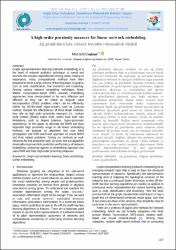A high order proximity measure for linear network embedding
Abstract
Graph representationion learning (network embedding) is at
the heart of network analytics techniques to reveal and
examine the complex dependencies among nodes. Owing its
importance, many computational methods have been
proposed to solve a large volume of learning tasks on graphs,
such as node classification, link prediction and clustering.
Among various network embedding techniques, linear
Matrix Factorization-based (MF) network embedding
approaches have demonstrated to be very effective and
efficient as they can be stated as singular value
decomposition (SVD) problem, which can be efficiently
solved by off-the-shelf eigen-solvers, such as Lanczos
method. Despite the effectiveness of these linear methods,
they rely on high order proximity measures, i.e., random
walk restarts (RWR) and/or Katz, which have their own
limitations, such as degree biasness, hyper-parameter
dependency. In this paper, to alleviate the RWR and Katz
depended high proximity usage in the linear embedding
methods, we propose an algorithm that uses label
propagation and shift-and-invert approach to resort RWR
and Katz related problems. Testing our methods on realnetworks for link prediction task, we show that our algorithm
drastically improves link prediction performance of network
embedding comparing against an embedding approach that
uses RWR and Katz high order proximity measures.


















